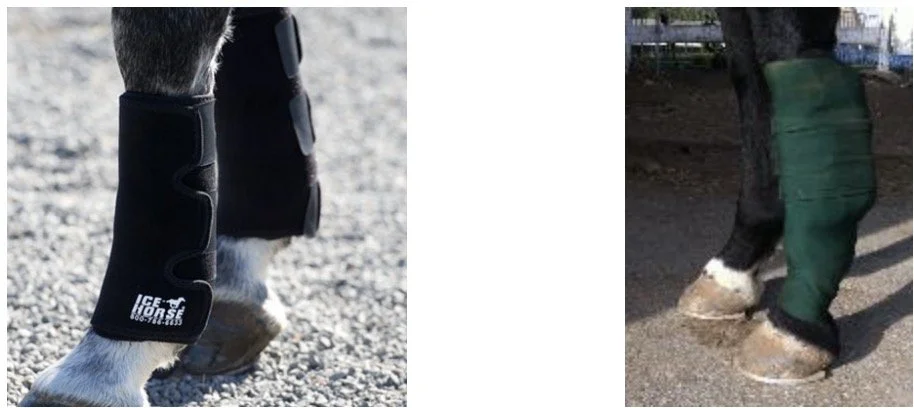Ice Treatment for Your Horse
Cold therapy has been used for a long time. It has an anti-inflammatory effect and is used on sore tendons, joints, and hooves. The question always arises as to what method is best used to apply cold therapy.
Choices include crushed ice and ice cubes, cold hosing, ice packs, and ice wraps. Another option is continuous cold therapy accomplished by connecting specialized wraps with circulating cold fluid cooled by an attached machine and a similar machine that adds intermittent compressive force in addition to application of cold.
Ice packs are somewhat easier than ice cubes and crushed ice which often need to be purchased that day in order to use. Standard gel-filled ice packs can be difficult because they freeze solid and will not conform well to a horse's leg. That decreases the surface area receiving the cold directly and makes it hard to apply.
One company has developed innovative reusable ice packs that have a unique ability to conform to your horse's leg. This allows for increased cold application to a greater surface area. The First Ice® packs made by Ice Horse (http://www.icehorse.net) have a gel that freezes but breaks up into many flakes instead of freezing into one solid mass. By having lots of little frozen flakes the pack can conform to the contours of your horse's leg. This is similar to the idea behind the tested benefits of using a bag of frozen peas when you have a bang or a bruise. Both work great because they easily contour to the applied area. This increases the rate of cold transfer from the ice pack to the treatment area as well as the surface area receiving the cold treatment.
Prior to applying these or any ice therapy, there is an important first step. Apply cold water to the treatment area prior to the application of the First Ice® packs. By wetting the hair you lower the hair's ability to insulate the leg from the ice pack and dramatically increase the cold transfer.
What is the best way to cool a horse's leg?
An Irish researcher tried comparing various methods of cooling a horse's leg. By doing careful measurements, she found that of the methods she tested ice packs worked best to lower the temperature in a horse's leg. At 15 minutes there was a drop of 30 degrees. Of note, she did her tests on horses prior to exercising so you must consider that her results are not exactly applicable for your purposes. When you are applying a cooling method it is most likely after exercise. She also found that several other methods cooled the leg at least 9 degrees for 15 minutes.
Another research effort at UC Davis found that one of the continuous cold and compression systems was able to lower the temperature of a flexor tendon by 21 degrees. This measurement was made at 1 hour following the device's application and measured inside the tendon itself. The Irish researcher did her measurements at the 15-minute mark.
My personal impression is that crushed ice mixed with water will cool the legs quickly and well, but can be hard to apply. The First Ice® packs are an excellent method to mimic the advantages of crushed ice without the mess. Practice is required when applying these ice packs and their attendant wraps used to hold them to your horse's leg. As the ice packs give up their heat and transfer cold to your horse's leg, they melt and lose some of their diameter. This can lead to slipping down your horse’s leg.
On my own horse, I used the following method to maximize their usefulness for cooling the tendon area behind the cannon bone. I take the ice packs out of the freezer and put them in a cooler while I am riding. This seems to let them melt just enough to maximize their ability to conform to my horse's leg. I wet down my horse's leg. Then I insert the ice packs into the neoprene wraps used to hold the ice packs against the leg and work to break the packs into many crystals in order to maximize their ability to conform to the leg. To try and prevent slippage I really tug on the velcro straps. In addition, starting on the leg below where the neoprene reaches and over top of the neoprene wrap I put something like a standing bandage. This combination works well to hold the ice packs in place and really cools the leg. I leave that on for 20-30 minutes.
Tendon Wrap before and after over wrapping with standing wrap



